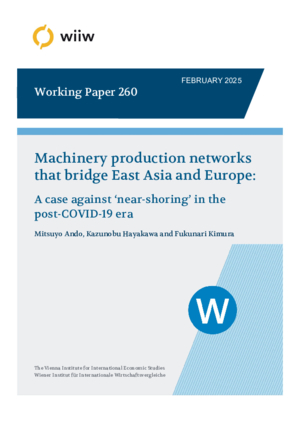Machinery production networks that bridge East Asia and Europe: A case against ‘near-shoring’ in the post-COVID-19 era
Mitsuyo Ando, Kazunobu Hayakawa and Fukunari Kimura
wiiw Working Paper No. 260, February 2025
44 pages including 18 Tables and 3 Figures
This study examines recent changes in international production networks facing various risks. We primarily investigate how import sources of the European Union (EU) countries in machinery industries have changed from the pre-pandemic to the post-pandemic period using monthly and annual international trade data at the finely disaggregated level, with a particular focus on East Asia. We confirm that Factory Asia experienced a much smaller negative impact and had a more rapid recovery from the COVID-19 pandemic compared with Factory America and Factory Europe, showing its robust and resilient nature. At least until 2023, the inter-regional linkages of East Asia as a supplier did not weaken. Moreover, we reveal that the two directions of links between East Asia and the EU are asymmetric. East Asian countries are important suppliers for the EU, particularly in general and electrical machinery industries, and the relative importance of the Association of Southeast Asian Nations (ASEAN) and China, in particular, as EU import sources strengthened further in the post-pandemic period. We also demonstrate that EU countries increased imports from longer-distance countries, indicating no quantitative evidence of intensifying near-shoring in machinery industries in the post-COVID-19 era. Furthermore, we demonstrate that EU countries have prioritised friend-shoring from an economic perspective but not necessarily from a political perspective when purchasing machinery products in the post-pandemic period.
Keywords: International production networks, machinery trade, East Asia, EU, near-shoring, friend-shoring, post-COVID-19
JEL classification: F14, F15, F53
Countries covered: East Asia, EU
Research Areas: International Trade, Competitiveness and FDI, Sectoral studies
